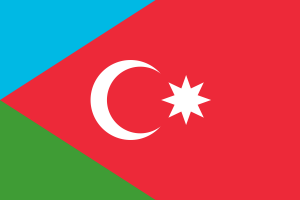Language/South-azerbaijani/Grammar/Subject-Object-Verb-Order
| ◀️ Introducing Yourself — Previous Lesson | Next Lesson — Negation ▶️ |
Introduction[edit | edit source]
In this lesson, we will explore the basic sentence structure in the South Azerbaijani language. Understanding the word order is essential for constructing meaningful sentences and conveying your thoughts accurately. South Azerbaijani follows a subject-object-verb (SOV) order, which means that the subject comes first, followed by the object, and finally the verb. This lesson will provide a comprehensive overview of this word order and its usage in various contexts. By the end of this lesson, you will have a solid foundation in constructing sentences with the correct subject-object-verb order.
Overview of Subject-Object-Verb Order[edit | edit source]
The subject-object-verb (SOV) order is a fundamental aspect of South Azerbaijani grammar. Unlike English and many other languages that follow a subject-verb-object (SVO) order, South Azerbaijani places the subject before the object and the verb at the end. This word order is consistent across various sentence types, including declarative, interrogative, and imperative sentences.
Let's take a look at a simple example to illustrate the subject-object-verb order:
| South Azerbaijani | Pronunciation | English Translation |
|---|---|---|
| مینا | Mina | Mina |
In this example, "مینا" (Mina) is the subject, "مینا" (Mina) is the object, and there is no verb. This sentence translates to "Mina."
Subject in South Azerbaijani Sentences[edit | edit source]
The subject is the noun or pronoun that performs the action or is being described in a sentence. In South Azerbaijani, the subject always comes before the object and the verb. Let's explore some examples:
Example 1[edit | edit source]
| South Azerbaijani | Pronunciation | English Translation |
|---|---|---|
| آدام | Adam | Adam |
In this sentence, "آدام" (Adam) is the subject, and there is no object or verb. It translates to "Adam."
Example 2[edit | edit source]
| South Azerbaijani | Pronunciation | English Translation |
|---|---|---|
| مامان | Maman | Mother |
In this sentence, "مامان" (Maman) is the subject, and there is no object or verb. It translates to "Mother."
Object in South Azerbaijani Sentences[edit | edit source]
The object in South Azerbaijani sentences receives the action or is being affected by it. Like the subject, the object also comes before the verb. Let's explore some examples:
Example 1[edit | edit source]
| South Azerbaijani | Pronunciation | English Translation |
|---|---|---|
| گل | Gol | Flower |
In this sentence, "گل" (Gol) is the object, and there is no subject or verb. It translates to "Flower."
Example 2[edit | edit source]
| South Azerbaijani | Pronunciation | English Translation |
|---|---|---|
| آب | Ab | Water |
In this sentence, "آب" (Ab) is the object, and there is no subject or verb. It translates to "Water."
Verb in South Azerbaijani Sentences[edit | edit source]
The verb is the action or state of being in a sentence. In South Azerbaijani, the verb always comes at the end of the sentence. Let's explore some examples:
Example 1[edit | edit source]
| South Azerbaijani | Pronunciation | English Translation |
|---|---|---|
| خورماخ | Xormax | Eat |
In this sentence, "خورماخ" (Xormax) is the verb, and there is no subject or object. It translates to "Eat."
Example 2[edit | edit source]
| South Azerbaijani | Pronunciation | English Translation |
|---|---|---|
| خواب | Xab | Sleep |
In this sentence, "خواب" (Xab) is the verb, and there is no subject or object. It translates to "Sleep."
Cultural Insights[edit | edit source]
The subject-object-verb order is not unique to South Azerbaijani. Many other Turkic languages, such as Turkish and Uzbek, also follow this word order. This similarity can be attributed to the historical and cultural connections between the Turkic-speaking regions.
In South Azerbaijani culture, storytelling holds great importance. Traditional folk tales and legends are often shared orally, and the subject-object-verb order is commonly used in these narratives. Understanding this word order is crucial for comprehending and appreciating the rich storytelling traditions of South Azerbaijani culture.
Practice Exercises[edit | edit source]
Now, let's practice constructing sentences with the subject-object-verb order. Translate the following sentences from English to South Azerbaijani, keeping the word order in mind. Solutions will be provided after each exercise for self-assessment.
Exercise 1[edit | edit source]
Translate the following sentence to South Azerbaijani: "The cat caught the mouse."
Solution:
| South Azerbaijani | Pronunciation | English Translation |
|---|---|---|
| پیشتریکی گوتی | Pişteriki goti | The cat caught the mouse. |
Exercise 2[edit | edit source]
Translate the following sentence to South Azerbaijani: "She bought a new dress."
Solution:
| South Azerbaijani | Pronunciation | English Translation |
|---|---|---|
| او ینی بیر گیپی | O yəni bir gipi | She bought a new dress. |
Conclusion[edit | edit source]
In this lesson, we explored the subject-object-verb order in South Azerbaijani sentences. We learned that the subject always comes first, followed by the object and then the verb. This word order is consistent across various sentence types and is an essential aspect of South Azerbaijani grammar. We also discussed the cultural significance of this word order in South Azerbaijani storytelling traditions. Finally, we practiced constructing sentences with the subject-object-verb order. With this knowledge, you are now equipped to construct meaningful sentences in South Azerbaijani. Keep practicing, and soon you will be able to express yourself fluently in this beautiful language.
Other Lessons[edit | edit source]
- Present Tense
- How to Use Have
- Pronouns
- Give your Opinion
- Adjective Agreement
- Gender
- Conditional Mood
- Adjectives
- 0 to A1 Course
- Future Tense
Template:South-azerbaijani-Page-Bottom
| ◀️ Introducing Yourself — Previous Lesson | Next Lesson — Negation ▶️ |

